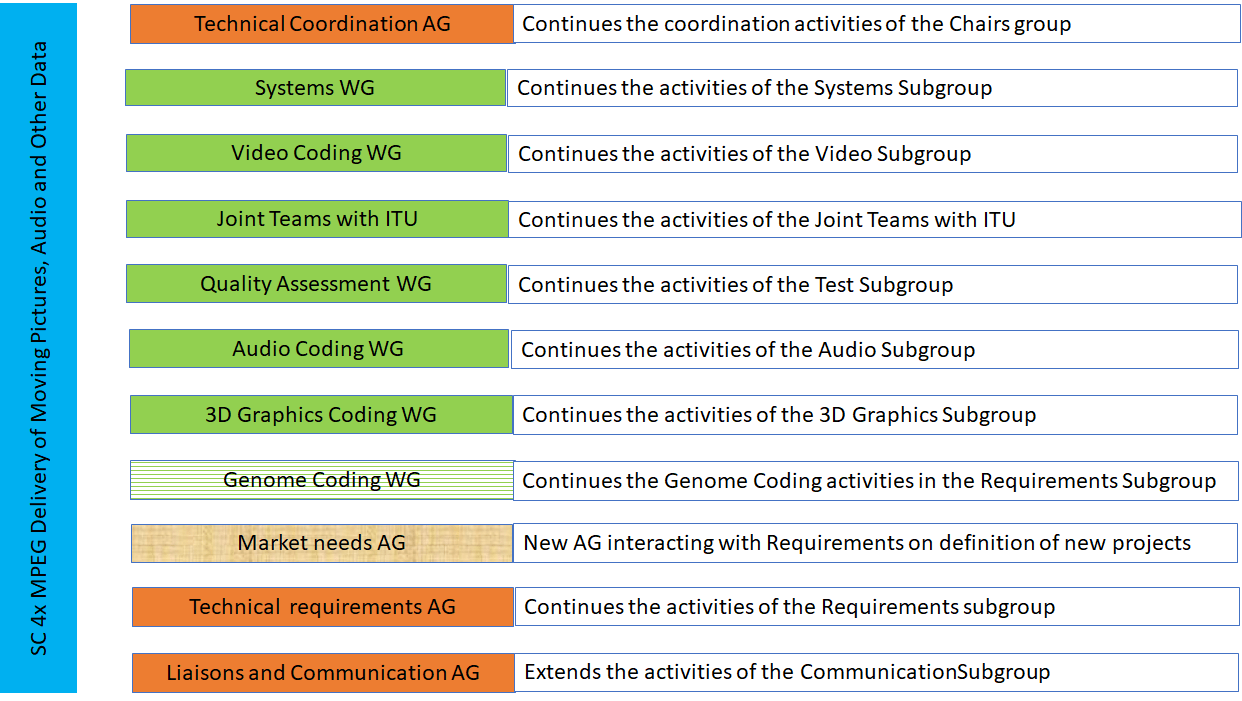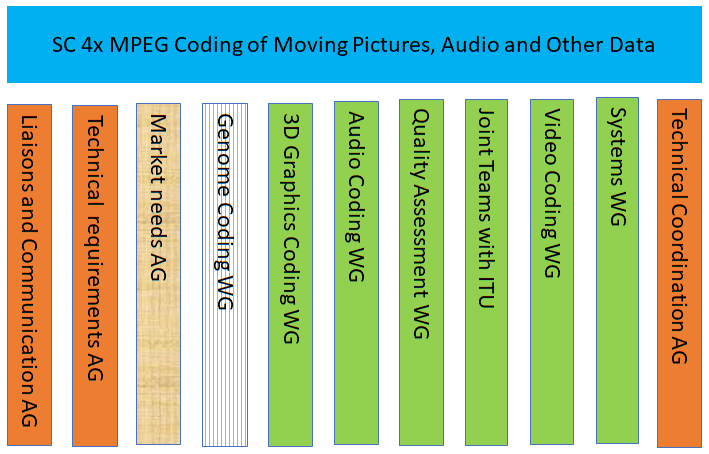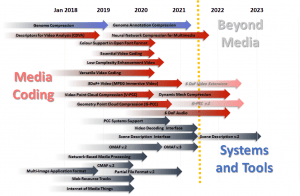A group of MPEG and JPEG members have developed a proposal seek to leverage the impact MPEG and JPEG standards have had on thousands of companies and billions of people all over the world.
A few numbers related to 2018 tell a long story. At the device level, the installed base of MPEG-enabled devices was worth 2.8 trillion USD and the value of devices in that year was in excess of 1 trillion USD. At the service level, the revenues of the PayTV industry were ~230 billion USD and of the total turnover of the global digital terrestrial television was ~200 billion USD.
So far MPEG and JPEG were hosted by Subcommittee 29 (SC 29). The group thinks that it is time to revitalise the 27-year old SC 29 structure. To achieve the goal, let’s make the following considerations:
- MPEG has been and continues to be able to conceive strategic visions for new media user experiences, design work plans in response to industry needs, develop standards in close collaboration with client industries, demonstrate their performance and promote their use.
- For many years MPEG and JPEG have provided standards to operate and innovate the broadcast, broadband and mobile distribution industries, and the imaging industry, respectively;
- MPEG and JPEG have become the reference committee for their industries;
- MPEG reference industries’ needs for more standards continue to grow causing a sustained increase in MPEG members attending (currently 600);
- JPEG and MPEG have a track record of widely deployed standards developed for and in collaboration with other committees that require a more appropriate level of liaison;
- MPEG and JPEG operate as virtual SCs, each with a structure of interacting subgroups covering the required areas of expertise, including a strategic planning function;
- MPEG and JPEG have independent and and universally recognised strong brands that must be preserved unfettered and enhanced;
- MPEG and JPEG are running standardisation projects whose operation must be guaranteed;
A Strengths-Weaknesses-Opportunities-Threats (SWOT) analysis has been carried out on MPEG. The results point to the need for MPEG
- To achieve an SC status compatible with its wide scope of work and large membership (1500 registered members and 600 attending physical meetings)
- To retain its scope and structure slightly amended to improve the match of standards with market needs and leverage internal talents
- To keep and enhance the MPEG brand.
This is the proposal
- MPEG becomes a JTC 1 SC (SC 4x) with the title “MPEG compression and delivery of Moving Pictures, Audio and Other Data”;
- JPEG becomes SC 29 with the title “JPEG Coding of digital representations of images”;
- MPEG/JPEG subgroups become working groups (WG) or advisory groups (AG) of SC 4x/SC 29. MPEG adds a Market needs AG;
- Both SC 4x and SC 29 retain existing collaborations with ITU-T and their collaborative stance with other committees/bodies, e.g. by setting up joint working groups (JWG);
- SC 4x may create, in addition to genomics, WGs/JWGs for compression of other types of data with relevant committees, building on MPEG’s common tool set;
- If selected as secretariat (a proposal for a new SC 4x requires that a National Body be ready to take the secretariat), the Italian National Body (ITNB) is willing to make the following steps to expedite a smooth transition:
- Nominate the MPEG convenor as SC 4x chair;
- Nominate an “SC 4x chair elect” from a country other than Italy using criteria of 1) con-tinuity of MPEG’s vision and strategy, 2) full understanding of the scope of SC 4x and 3) record of performance in the currently held position;
- Call for nominations of convenors of SC 4x working groups (WG). We nominate current subgroup chairs as convenors of the respective WG
The proposal brings a significant number of benefits
- It has a positive impact on the heavy load of MPEG and JPEG work plans:
- It supports and enhances MPEG work plan, as MPEG is moved to SC 4x, retaining its proven structure, modus operandi and relationships with client industries in scope;
- It supports and enhances JPEG work plan, as SC 29 elevates JPEG SGs to WGs, retaining its proven modus operandi and relationships with client industries in scope;
- It preserves and builds upon the established MPEG and JPEG brands;
- It retains and improves all features of MPEG success, in particular its structure and modus operandi:
- SC 4x holds its meetings collocated with the meetings of its WGs and AGs requesting to meet;
- SC 4x facilitates the formation of break-out groups during meetings and of ad hoc groups in between meetings;
- SC 4x exploits inter-group synergies by facilitating joint meetings between different WGs and AGs during physical meetings;
- SC 4x promotes use of every ICT tools that can improve its effectiveness, e.g. teleconferencing and MPEG-specific IT tools to support standards development.
- It enhances MPEG’s and JPEG’s collaboration stance with other committees via Joint Working Groups;
- It improves MPEG’s supplier-client relationship with its client industries with its new status;
- It adds formal governance to the well-honed MPEG and JPEG structures;
- It balances continuity and renewal of MPEG leadership at all levels;
- It formalises MPEG’s and JPEG’s high-profile standard reference roles for the video and image sectors, respectively.
Upon approval by JTC 1 and ratification by the TMB, SC 4x will assume the following
- Title: MPEG compression and delivery of moving pictures, audio and other data;
- Scope: Standardisation in the area of efficient delivery of moving pictures and audio, their descriptions and other data
- Serve as the focus and proponent for JTC 1’s standardisation program for broadcast, broadband and mobile distribution based on analysis, compression, transport and consumption of digital moving pictures and audio, including conventional and immersive, generated or captured by any technology;
- Serve as the focus and co-proponent for JTC 1’s standardisation program on efficient storage, processing and delivery of genomic and other data, in agreement and collaboration with the relevant committees.
- WG 11 subgroups become:
- SC 4x Advisory Groups (AG) – do not produce standards;
- SC 4x Working Groups (WG) – produce standards;
- Minor adjustments to WG 11 subgroup structure made to strengthen productivity:
- New Market needs AG to enhance alignment of standards with market needs (to be installed at an appropriate time after establishment of SC 4x);
- Genome Coding moves from a Requirements activity to WG level;
- SC 4x retains WG 11’s collaborative stance with other committees/bodies, e.g. Collaborative Teams with ITU-T on Video Coding and Joint Working Groups with ISO/IEC committees to carry out commonly agreed projects;

Joint Working Groups (JWG) may be established if the need for common standards with other ISO/IEC committees is identified.
SC 4x will constantly monitor the state of standards development and adapt its structure accordingly, including by establishing new WGs, e.g. on standards for other data types.
- For the time being, to effectively pursue its standardisation goals, SC 4x will continue its practice of quarterly meetings collocated with its AGs and WGs (same time/place) organised as an “SC 4x week”, virtually the same of that of MPEG. Extended plenaries are joint meetings of all WGs/AGs. SC 4x plenaries held on the Sunday before and during an hour after the extended plenary on Friday. The last plenary deals with matters such as liaisons, meeting schedules etc that used to be handled by WG 11 plenaries
| Day | Time | Meeting | Chaired by |
| Sunday | 14-16 | SC 4x plenary | Chair |
| Monday | 09-13 | Extended SC 4x plenary to review AhG reports and plan for the week | Chair elect |
| Wednesday | 09-11 | Extended SC 4x plenary to review work done so far by AGs/WGs and plan for the rest of the week | Chair elect with Tech. Coord. AG Convenor |
| Friday | 14-17 | Extended SC 4x plenary to review and approve recommendations produced by AGs/WGs | Chair |
| Friday | 17-18 | Plenary to act on matters requiring SC 4x intervention | Chair |
- WGs and AGs could have longer meeting durations (i.e. start before first SC 4x meeting);
- Carry out a thorough review of all details of meeting sessions, agendas, document registration etc. with the involvement of all affected experts;
- Institut Mines Télécom’s unique services offered for the last 15 years would be warmly welcome to preserve and continually improve WG 11’s operating efficiency with the involvement of all WG/AG members.
(the following is a first attempt at defining the SC 29 title and scope after creation of SC 4x)
Upon approval by JTC 1, SC 29 will change its title and scope as follows:
- Title: JPEG coding of digital representations of images
- Scope: Development of international standards for
- Efficient digital representations, processing and interchange of conventional and immersive images
- Efficient digital representations of image-related sensory and digital data, such as medical and satellite
- Support to digital image coding applications
- Maintenance of ISO/IEC 13522
- WG 11 subgroups become:
- SC 4x Advisory Groups (AG) – do not produce standards;
- SC 4x Working Groups (WG) – produce standards;
- SC 29 may set up Joint Working Groups, e.g. with SC 4x and TC 42, to carry out commonly agreed projects;
(the following is a first attempt at defining the SC 29 structure after creation of SC 4x, using the current SG structure of WG 1)

- SC 29 meetings: similar organisation as currently done by JPEG.
Why MPEG and JPEG do not work together?
This is a reasonable question, and has a simple answer. They can and should, however, the following should be taken into consideration
In an MPEG moving picture codec, there is always a still picture coding mode, a mode of the general moving picture coding scheme, whose tools are a subset of the tools of the complete moving picture coding scheme.
No need or significant benefit has ever been found that justifies the adoption of a JPEG image coding scheme, as the still picture coding mode of an MPEG moving picture coding scheme. Ditto for other schemes
There is no reason to believe that the same should not apply to such media types as point cloud and lightfield. The still picture coding mode of a dynamic (time dependent) point cloud or lightfield coding scheme uses coding tools from the general coding scheme, not those independently developed for images.
Image compression schemes have their own market. separate from the market of moving picture compression schemes. Often the market for images anticipates the market for moving pictures. That is why independent JPEG standards can be useful.
Posts in this thread
- MPEG and JPEG are grown up
- Standards and collaboration
- The talents, MPEG and the master
- Standards and business models
- On the convergence of Video and 3D Graphics
- Developing standards while preparing the future
- No one is perfect, but some are more accomplished than others
- Einige Gespenster gehen um in der Welt – die Gespenster der Zauberlehrlinge
- Does success breed success?
- Dot the i’s and cross the t’s
- The MPEG frontier
- Tranquil 7+ days of hard work
- Hamlet in Gothenburg: one or two ad hoc groups?
- The Mule, Foundation and MPEG
- Can we improve MPEG standards’ success rate?
- Which future for MPEG?
- Why MPEG is part of ISO/IEC
- The discontinuity of digital technologies
- The impact of MPEG standards
- Still more to say about MPEG standards
- The MPEG work plan (March 2019)
- MPEG and ISO
- Data compression in MPEG
- More video with more features
- Matching technology supply with demand
- What would MPEG be without Systems?
- MPEG: what it did, is doing, will do
- The MPEG drive to immersive visual experiences
- There is more to say about MPEG standards
- Moving intelligence around
- More standards – more successes – more failures
- Thirty years of audio coding and counting
- Is there a logic in MPEG standards?
- Forty years of video coding and counting
- The MPEG ecosystem
- Why is MPEG successful?
- MPEG can also be green
- The life of an MPEG standard
- Genome is digital, and can be compressed
- Compression standards and quality go hand in hand
- Digging deeper in the MPEG work
- MPEG communicates
- How does MPEG actually work?
- Life inside MPEG
- Data Compression Technologies – A FAQ
- It worked twice and will work again
- Compression standards for the data industries
- 30 years of MPEG, and counting?
- The MPEG machine is ready to start (again)
- IP counting or revenue counting?
- Business model based ISO/IEC standards
- Can MPEG overcome its Video “crisis”?
- A crisis, the causes and a solution
- Compression – the technology for the digital age




